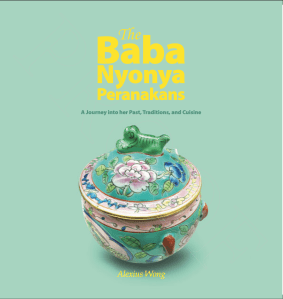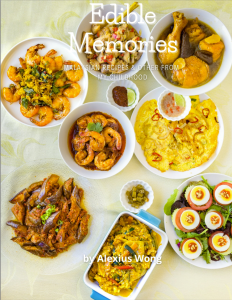
If there were one dish that could be representative of Nyonya cooking from the Malacca Peranakan community, it would be this wonderful, hearty, and flavorful stew. Here we see the Peranakan penchant for using pork belly, as in many other pork dishes, paired with potatoes and Chinese mushrooms, cooked in Chinese salty bean sauce, and served with the spicy and pungent condiment, sambal belacan.
When I was writing this recipe, my aunt Madam Dolly Lee Kim Neo reminisced that instead of potatoes in the version that I was accustomed to, Mamah used to cook it with bamboo shoots when Auntie Dolly was a child. I did not quite believe her at first since I could only recall eating the dish with wedges of potato in it. One day, my father gave me a small cookbook from Singapore on Nyonya cuisine. The Singapore Peranakan culture is an extension of the Malacca prototype since many from Malacca migrated to the southern island when it became a trading port. In that cookbook, there was a recipe for pongteh, and, lo and behold, it was made with bamboo shoots. The same auntie also told me that it was my maternal grandmother, Madam Leong Yoke Fong, and not my paternal grandmother (her mother), who introduced Chinese mushrooms to the dish. Later on, I found out from my cousin Moses that this same grandmother occasionally would also add sengkuang (jicama) and white peppercorns to her version. The original recipe most likely would have used bamboo shoots since bamboo trees grew abundantly in the countryside. In addition, Chinese mushrooms had to be imported and were considered a luxury item, only used by city folk or wealthier Peranakan families. My maternal grandmother, who was raised in the Chinese culture, married into a fairly wealthy Peranakan family in Alor Gajah, which explains her addition of this expensive ingredient to the dish.
The amount of shallots and garlic seems excessive, but they are essential to providing a rich flavor as well as the thickening agent for the sauce. An important tip is to fry the potato wedges quickly in hot oil until a golden-brown crust forms so the potato does not fall apart in the stew, otherwise it will make the sauce mealy in texture. Another is not to cook the potatoes in the stew for too long—you may remove them once they are done. The Dutch most likely introduced the potato to the Malay Peninsula since they were cultivating it in the Philippines during the late sixteenth century, and by the seventeenth century in Java. It was around that time that the Dutch entered and controlled Malacca. You may add some sugar to make the sauce slightly sweet, but my family has an aversion for sugar in our savory dishes.
When I used to visit my aunt Madam Nancy Guan in Bukit Rambai, seven miles north of Melaka town, she would always prepare this dish for us with a customary layer of pork fat shimmering on the surface. My siblings and I would relish the rare opportunity to eat it Malay-style, with our fingers, to my father’s slight disapproval; here, her seniority trumped his preference. It was amazing how she could whip up a Peranakan feast for us even when we paid a surprise visit, and this stew was de rigueur on the table alongside a cooked chicken from her backyard, slaughtered upon our arrival.
If you feel that this dish is too fatty, you can remove as much fat as you want. Do not substitute the belly with any lean meat, like pork loin, but with a cut of meat that is capable of being stewed for some time—even chicken thighs and drumsticks make a great version. Make sure to serve it with the spicy condiment sambal belacan with some lime juice added to it, just as our family has always savored this dish. You will see why we ate this dish weekly in our household, and also the reason why my granduncle Mr. Lee Mui Loke insisted that my paternal grandmother cooked it every time he went back to visit relatives in the family village.
Like most stews, especially Nyonya ones, this tastes even better the following day, and its strong flavors and richness would hardly deter a true Peranakan from indulging in it for breakfast the next morning with some rice or toasted bread, as is the case with my family—you may find you agree.
Recipe from The Baba Nyonya Peranakans book
Serves 4 to 6
Mushroom soaking time: 1 hour
Preparation time: 1 hour, 15 to 1 hour, 30 minutes
20 small (200 grams/7 ounces) shallot, peeled and finely sliced
9 cloves (30 grams/1 ounce) garlic, peeled and finely sliced (2 ¼ tablespoons minced)
1 cup vegetable oil
2 medium potatoes, peeled and cut into medium-size wedges (2½ cups)
3 tablespoons ground bean sauce (Cantonese: meen see)
500 grams (1 pound) pork belly, cut into medium-size bites, or 1 kilo (2 pounds) bone-in chicken thighs and/or drumsticks
5 to 7 large dried Chinese mushrooms, soaked in hot water for 1 hour, stemmed, and cut into bite-size pieces (soaking water reserved)
Thin soy sauce
½ tablespoon sugar or more to taste (optional)
- In a food processor, purée the shallot and garlic into a fine paste. Set it aside.
- In a pan on high heat, heat the oil. Quickly fry the potato until golden brown but not fully cooked through. Remove, drain, and set aside.
- Pour out the oil from pan and place 10 tablespoons (just over ½ cup) back. Lower the heat to medium and fry the shallot-garlic mixture until aromatic but not browned, about 3 minutes. Add the bean sauce and quickly fry for 1 minute.
- Increase the heat to medium-high, add the pork belly, stir well, and cook until the surface no longer looks raw, 5 to 7 minutes.
- Add the mushroom soaking water and enough water to make a total of 3 cups to the pan. Add the mushrooms. Reduce the heat to medium. Partially cover the pan with a lid and bring to a boil. Add the potato wedges and boil until the potatoes are completely cooked, about 10 minutes, then remove the potatoes and set them aside.
- Reduce the heat to medium-low and simmer with the lid ajar for 35 minutes more. Stir occasionally, and add some water if the sauce gets too thick. Taste and adjust the seasoning with light soy sauce. Add the sugar (if using).
- Skim off some of the excessive oil from the top before serving. Add the potato wedges back to the pot and heat for a minute before serving.
- Serve with sambal belacan mixed with some lime juice.


The hardcopy and e-book of The Baba Nyonya Peranakans book (1st image) and Edible Memories e-cookbook (2nd image) are available – more information on the Homepage.

In the above recipe, I think you meant 500g or 1/2 kg pork belly (not 1/2 lb) right.
I love pongteh and often cook it at home, both the pork and chicken versions. Thank you for the recipe and background. I am not nyonya though but love nyonya food.
LikeLike
Hi Sophie. Thanks for pointing the oversight. I meant to write 1 pound. I made the correction. Hope you try the recipe. Thanks
LikeLike
Hi
You mentioned that the Dutch introduced the potato to the Malay peninsular because they were cultivating it in the Philippines. Historically, the Dutch never occupied the Philippines and could not have cultivated it there since the Spanish were occupying the Philippines. You are probably referring to the their occupation of the Dutch East Indies?
LikeLike
Hi, thanks for your comment. You are right to say that the Dutch never occupied the Philippines. The Dutch had trade relations with this nation, mostly underground, and were probably interested in securing her, but this was thwarted by the Spaniards. Hence their introduction of potato in both these islands and Batavia.
LikeLike
We cooked this at the weekend and the leftover was even better on Monday, as the flavour matured It was easy to cook and we’ll tried it again!
LikeLike
Hi Albert. I was glad to read your positive comments as you had a successful try of the recipe. Glad you enjoyed the leftovers, and yes, they are more flavorful. Hope you will have a successful run with the other recipes too.
LikeLike